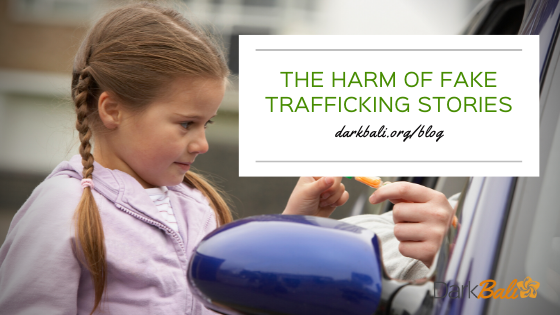Last year, the world’s attention has turned toward human trafficking in new numbers. Particularly in the United States, #savethechildren made headlines as supporters took to the streets seemingly in support of victims of child trafficking. On social media, story after story was shared about people who believed they or their children had narrowly escaped being trafficked in a grocery store parking lot. While I am grateful for the attention that these stories have brought to the human trafficking movement, I want to be honest about the impact because intentions and impact are two different things. The truth is that these stories cause damage to the anti-trafficking movement and silence the voices of real survivors.
If you wade through the fake human trafficking stories, what you find is that there is a common thread of identification. The “victims” of the stories are relatable to the average person. This draws the reader into the story because they can imagine themselves or a child in their lives as the victim. That is why nearly all movies involving human trafficking show middle class girls from loving families getting snatched off the streets. It is a compelling image to most people, but it is rarely reality.
Traffickers are smart. They do not tend to go after children who have parents who will look for them. They go after the runaways and homeless, the kids who have aged out of foster care and are on their own, and the ones in the middle of migration whose parents don’t even know where they are. Real human trafficking stories are always complicated, but they aren’t as approachable for the average person because we are fortunate to have little or no experiences with the typical traumas that often eventually lead to trafficking.
The middle class girl snatched from her neighborhood sidewalk is a much easier sell than the story of the teenage girl who was moved around to different foster homes until she ran off with her boyfriend who pimped her out so they could both get their next opiate fix. The first is a Hollywood movie; the second is reality. In Indonesia, the stories of survivors begin with poverty and/or child marriage, and they end with migration and the complicated choices that a teenage girl should never have to make in order to stay alive.
The truth is that we like the dramatic stories of the children from homes like ours because those problems are easy to solve. If human trafficking looked like Hollywood movies, all we really need is good prevention education, strong law enforcement, and a Liam Neeson in a pinch. In contrast, the stories of actual human trafficking survivors demand that we acknowledge and address issues like poverty, immigration, addiction, and broken systems. This requires more from us than a share on social media, a street sign, or a conversation about stranger danger with our children.
Luckily, the average person can become an ally to survivors and an asset in the anti-trafficking movement. It takes a commitment to listen to survivors to hear the real stories even when they are complicated and have no easy solutions and make us uncomfortable. It takes doing some homework to ensure that the organizations you support are legitimate and the stories that you share are true. These are the kind of allies that anti-trafficking organizations need – ones who can live in the tension of the complexities and honor the reality of the lived experiences of survivors without judgement. We need people who are in it for the long haul, tackling the problems that lead to trafficking in the first place, rather than those who are in it for a few likes.
(For more information about how you can support legitimate anti-trafficking organizations, see our post on 10 Ways You Can Support Anti-Trafficking Without Spending a Dime. You can also check out our ACT page for more ideas.)






